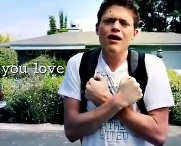Example #4: Christina Aguilera’s “Beautiful”
Let’s end with another ASL music video by D-PAN, the Deaf Professional Arts Network (2008), this one featuring adults signing Christina Aguilera’s “Beautiful.” This song does not include subtitles to accompany Aguilera’s spoken lyrics, but the camera frames bodies to emphasize the beauty of sign language, emotions, and the lyrics. Centralizing the movement of the hands in capturing language reflects “ASL’s simultaneous foregrounding of the visual-spatial-kinetic dimensions of [lived] experience” (Bauman, 2003, p. 35). While foregrounding the visual experience renders the meaning inaccessible to those who cannot see, I want us to consider how this video embodies the beauty of differences in communication.
According to D-PAN (n.d.), by not showing the faces of the performers, the camera is “making the user focus on the sign language in the video and driving home the point that beauty isn’t about what’s visible at first glance, it’s about what comes from expressing ourselves” (Our Story section, para. 4). Through D-PAN’s (2008) composition, the visual modes of body language, visual text, and imagery harmonize in ways that make manifest the abstract concept of beauty (see video clip below).
In the clip from D-PAN’s (2008) video “D-PAN ASL music video: ‘Beautiful’ by Christina Aguilera” above, the camera fades in and out on the bodies of several individuals who sign the emotional content of the lyrics. Their faces remain cut out of the frame, reflecting the content of the song, whose lyrics include “Don’t look at me” and “We are beautiful no matter what they say,” as evocated by the performers.
We begin to see multiple modes combining to express synchronized meaning. A female individual smashes away the large words “Dumb,” “Stupid,” “Idiot,” “Ignorant,” and “Unable” as Aguilera sings, “Yes, words can’t bring me down… Oh no. So don’t you bring me down today.” The striking combination of sign language, physical gestures, and visual text to reflect the spirit of the spoken lyrics becomes more powerful through their juxtaposition than any single mode could on its own.
The artful interaction of words and bodies continues throughout the video. As Aguilera sings, “to all your friends you’re delirious,” a mirror appears reflecting a female individual who moves her hands around a visual text that says “Delirious” in large red font and that fades out as that line ends. She encapsulates the visual text with through her signs and gestures, taking control of the word and wiping it away through her actions. This is a symbolic and beautiful gesture of empowerment over actions and words.
The combination of kinesthetic and alphabetic words occurs throughout the video, either with words surrounding individuals to formulate the lyrical content of the song, or with images dissipating and emerging. The video ends with each featured individual fingerspelling the word B-E-A-U-T-I-F-U-L laid over the same letters in print typology. Sign language overlays visual text as the two modalities become one.
D-PAN’s (2008) “Beautiful” makes apparent M. Remi Yergeau’s (2009) argument that our bodies are texts that are authored/constructed by others even as we attempt to communicate our own differences. Yergeau wrote, “I think that text properly refers to living, breathing bodies, especially since many hip writers often conceive of words as being alive, of words as jumping off of pages. My body is text personified” (Meta 1 section, para. 1). Through viewing this video, we can recognize how Deaf individuals in D-PAN’s (2008) “Beautiful” have personified meaning through the movement of their bodies with and against alphabetic text. The words come alive in the air around the bodies and through the movement of the hands: Differences are beautiful.
This video embodies the creation of language and values (sign language is beautiful) through the movement of the body in relation with the world. The ways that these bodies interact with visual text and images reflects Yergeau’s (2009) argument that her body, as a text, has a language and a unique rhetoric of its own that “diverge[s] from mainstream rhetorics” (Meta 1 section, para. 3). Each body has a language, a unique rhetoric, and each body is beautiful in its own different way. The rhetorical message of D-PAN’s (2008) “Beautiful” becomes apparent through the personification of the message in these signing bodies.
This video could be seen as an accompaniment to Brenda Jo Brueggemann’s (1999) call on us to see deafness as a valuable difference and celebrate different ways of interpreting the world. Similarly, W.J.T. Mitchell’s (2006) preface to Signing the Body Poetic declared that ASL literature “is about poetics—about the movement… the moment when language takes flight and creates new worlds out of words and images” (p. xvi). We can see words and images create a multisensory poetry of meaning in D-PAN’s (2008) “Beautiful” and other videos.
ASL music videos are poetic compositions that create movement across different senses and modes. They make apparent that we can, and should, communicate across multiple modes to make our meaning accessible to others. They are opportunities for students to analyze how different bodies and rhetorics can interact with different modes in creating a multisensory, meaningful experience.
NEXT: Crescendo
